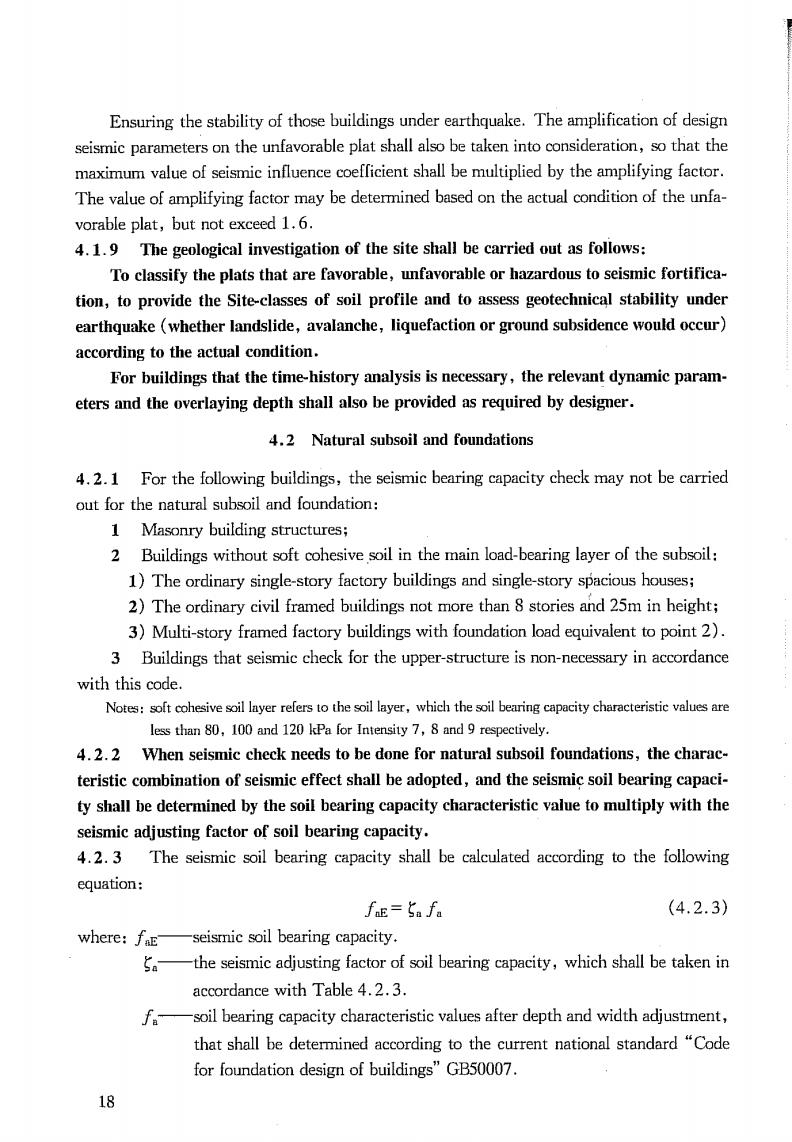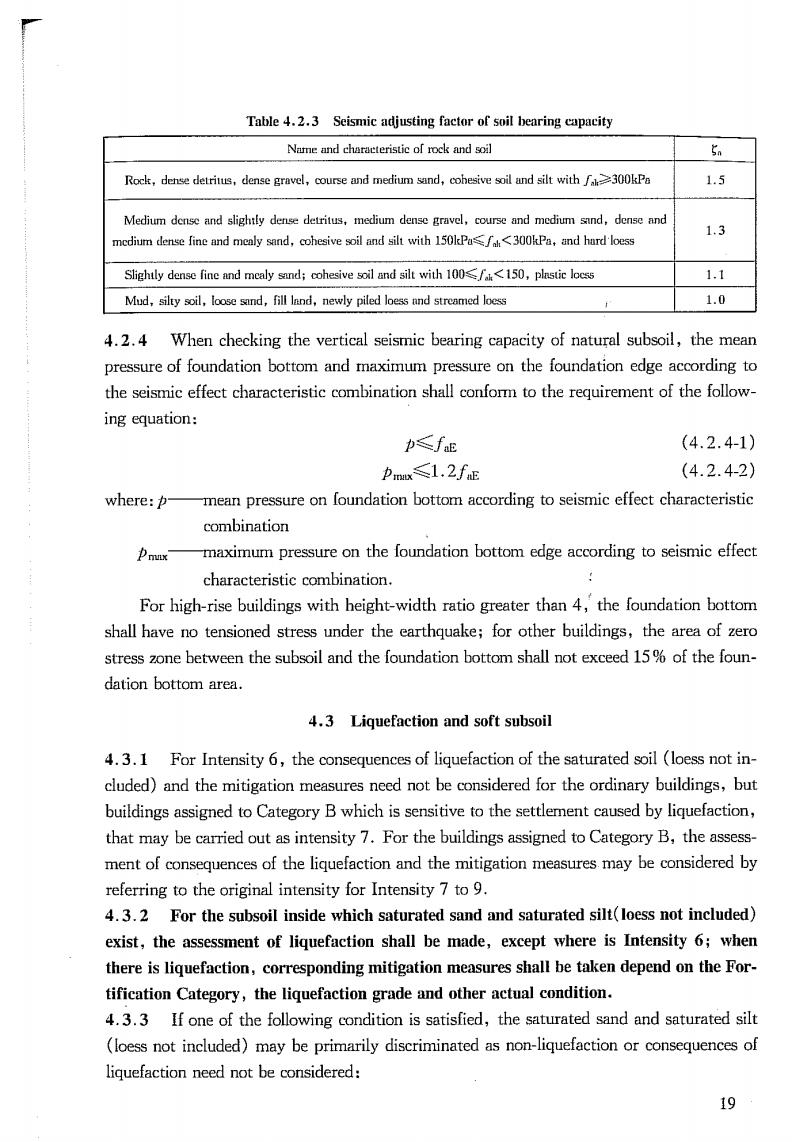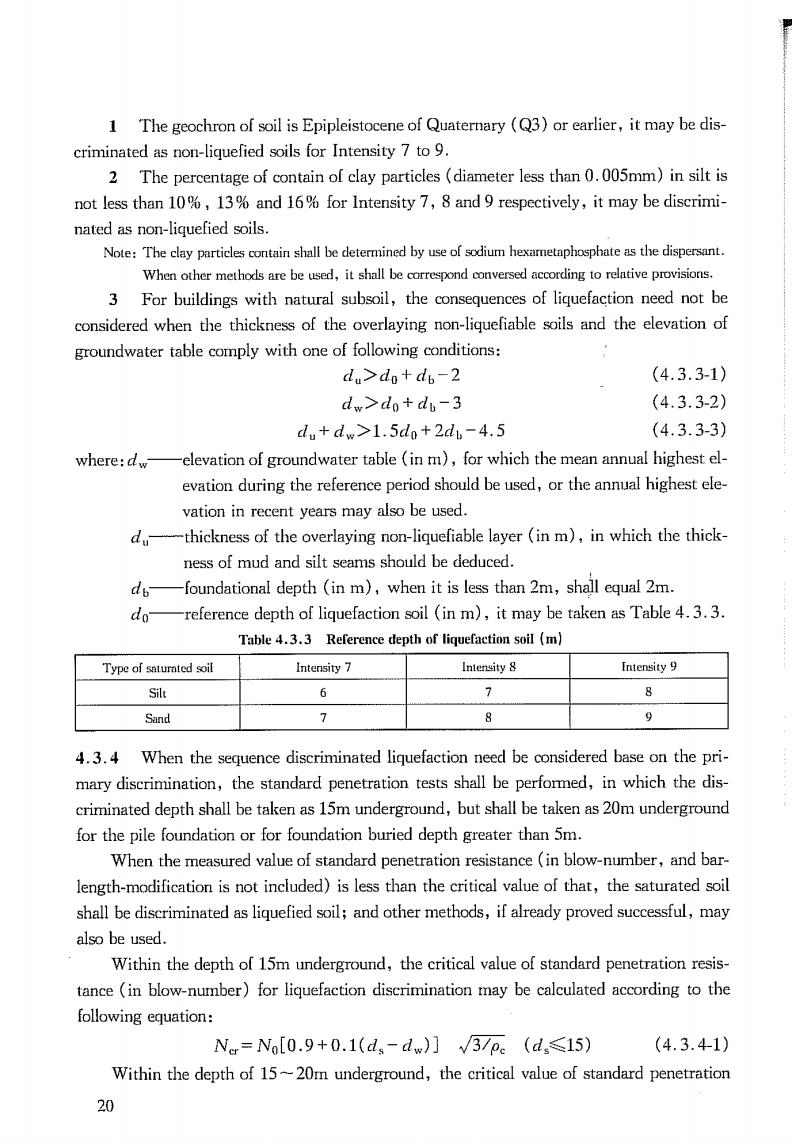
Ensuring the stability of those buildings under earthquake.The amplification of design seismic parameters on the unfavorable plat shall also be taken into consideration,s that the maximum value of seismic influence coefficient shall be multiplied by the amplifying factor. The value of amplifying factor may be determined based on the actual condition of the unfa- vorable plat,but not exceed 1.6. 4.1.9 The geological investigation of the site shall be carried out as follows: To classify the plats that are favorable,ufavorable or hazardous to seismic fortifica- tion,to provide the Site-classes of soil profile and to assess geotechnical stability under earthquake (whether landslide,avalanche,liquefaction or ground subsidence would occur) according to the actual condition. For buildings that the time-history analysis is necessary,the relevant dynamic param- eters and the overlaying depth shall also be provided as required by designer. 4.2 Natural subsoil and foundations 4.2.1 For the following buildings,the seismic bearing capacity check may not be carried out for the natural subsoil and foundation: 1 Masonry building structures; 2 Buildings without soft cohesive soil in the main load-bearing layer of the subsoil 1)The ordinary single-story factory buildings and single-story spacious houses; 2)The ordinary civil framed buildings not more than 8 stories and 25m in height; 3)Multi-story framed factory buildings with foundation load equivalent to point 2). 3 Buildings that seismic check for the upper-structure is non-necessary in accordance with this code. Notes:soft cohesive soi nyer refers to the soil layer,which the soil bearing capacity characteristic values are 4.2.2 When seismic check needs to be done for natural subsoil foundations,the charac- teristic combination of seismic effect shall be adopted,and the seismic soil bearing capaci- ty shall be determined by the soil bearing capacity characteristic value to multiply with the seismic adjusting factor of soil bearing capacity. 4.2.3 The seismic soil bearing capacity shall be calculated according to the following equation: fE=Safa (4.2.3) where:faE seismic soil bearing capacity. the seismic adjusting factor of soil bearing capacity,which shall be taken in accordance with Table 4.2.3. f。 -soil bearing capacity characteristic values after depth and width adjustment, that shall be determined according to the current national standard "Code for foundation design of buildings"GB50007. 18

Table4.2.3 Seismic adjusting factor of soil bearing eapacity Name and charaeteristic of rock and soil 1.5 1.3 Slightly dense fine and mcaly snd cohesive si andsilt with 10150,pstico 1.1 Mud,silty soil,loose sand,fill land,newly piled loess and streamed loess 1.0 4.2.4 When checking the vertical seismic bearing capacity of natural subsoil,the mean pressure of foundation bottom and maximum pressure on the foundation edge according to the seismic effect characteristic combination shall conform to the requirement of the follow- ing equation: p≤fE (4.2.4-1) pmx≤1.2fE (4.2.4-2) where:p- mean pressure on foundation bottom according to seismic effect characteristic combination Pmax -maximum pressure on the foundation bottom edge according to seismic effec characteristic combination. For high-rise buildings with height-width ratio greater than 4,the foundation bottom shall have no tensioned stress under the earthquake;for other buildings,the area of zero stress zone between the subsoil and the foundation bottom shall not exceed 15%of the foun- dation bottom area. 4.3 Liquefaction and soft subsoil 4.3.I For Intensity 6,the consequences of liquefaction of the saturated soil (loess not in- cluded)and the mitigation measures need not be considered for the ordinary buildings,but buildings assigned to Category B which is sensitive to the settlement caused by liquefaction. that may be carried out as intensity 7.For the buildings assigned to Category B,the assess- ment of consequences of the liquefaction and the mitigation measures may be considered by referring to the original intensity for Intensity 7 to9. 4.3.2 For the subsoil inside which saturated sand and saturated silt(loess not included) exist,the assessment of liquefaction shall be made,except where is Intensity 6;when there is liquefaction,corresponding mitigation measures shall be taken depend on the For tification Category,the liquefaction grade and other actual condition. 4.3.3 If one of the following condition is satisfied,the saturated sand and saturated silt (less not included)may be primarily discriminated as non-liquefaction or consequences of liquefaction need not be considered: 19

1 The geochron of soil is Epipleistocene of Quaterary (Q3)or earlier,it may be dis- criminated as non-liquefied soils for Intensity 7 to 9. 2 The percentage of contain of clay particles(diameter less than 0.005mm)in silt is not less than 10%,13%and 16%for Intensity 7,8 and9 respectively,it may be discrimi- nated as non-liquefied soils. 3 For buildings with natural subsoil,the consequences of liquefaction need not be considered when the thickness of the overlaying non-liquefiable soils and the elevation of groundwater table comply with one of following conditions: du>do+dp-2 (4.3.3-1) dw>do+d-3 (4.3.3-2) d.+dw>1.5do+2d-4.5 (4.3.3-3) where:dw elevation of groundwater table (in m),for which the mean annual highest el- evation during the reference period should be used,or the annual highest ele- vation in recent years may also be used. -thickness of the overlaying non-liquefiable layer (in m),in which the thick- ness of mud and silt seams should be deduced. d -foundational depth (in m),when it is less than 2m,shall equal 2m. do- -reference depth of liquefaction soil (in m),it may be taken as Table 4.3.3. Table 4.3.3 Reference depth of liquefaction soil (m) Type of sumted sil Intersity 7 Intensity 8 Intensity9 Silt 6 7 8 Sand 7 8 4.3.4 When the sequence discriminated liquefaction need be considered base on the pri- mary discrimination,the standard penetration tests shall be performed,in which the dis- criminated depth shall be taken as 15m underground,but shall be taken as 20m underground for the pile foundation or for foundation buried depth greater than 5m. When the measured value of standard penetration resistance (in blow-number,and bar- length-modification is not included)is less than the critical value of that,the saturated soil shall be discriminated as liquefied soil;and other methods,if already proved successful,may also be used. Within the depth of 15m underground,the critical value of standard penetration resis- tance (in blow-number)for liquefaction discrimination may be calculated according to the following equation: N.=N[0.9+0.1(d,-dw)]√3/pe(d≤15) (4.3.4-1) Within the depth of 15-20m underground,the critical value of standard penetration 20

resistance (in blow-number)for liquefaction discrimination may be calculated according to the following equation: Ne=N(2.4-0.1dm)√3/p(15≤d.≤20) (4.3.42) where:Na- critical value of standard penetration resistance(in blow-number)for lique faction discrimination; No- -reference value of standard penetration resistance(in blow-number)for liq- uefaction discrimination,it shall be taken from Table 4.3.4; d。 depth of standard penetration for saturated soil (inm); Pe percentage of clay particle content;when it is less than 3%or when the soil is sand,the value shall equal 3%. Table 4.3.4 Refcrence value of standard penetration resistance (n blw-r) Intensity 7 Intensity 8 Intensity 9 Group Ist 6(8) 10(13) 6 Group 810) 12(15) 18 Note:Values in the brackets are ued for the design basic elerofgound motion is15gand 0.30g. 4.3.5 For the subsoil with liquefied soil layers,the level and thickness of soil layer shall be explored and the liquefaction index shall be calculated by the following equations,and then the liquefaction grades shall be comprehensively classified according to Table 4.3.5: (4.3.5) where:Iie-liquefaction index. -total number of standard penetration test points in each bore within the dis- criminated depth under the ground surface. Ni,Nai- -measured value and critical value of standard penetration resistance (in blow. number)at the i-th point respectively,when the measured value is greater than the critical value,shall take as equal critical value. d thickness of soil layer (in m)at the i-th point,it may be taken as half of the difference in depth between the upper and lower neighboring standard pene tration test points;but the upper point level shall not be less than the eleva- tion of groundwater table,and the lower point level not greater than the liq- uefaction depth weighted function value of the i-th soil layer (in m),which is considered the effect of the layer portion and level of the unit soil layer thickness.For discrimination depth is 15m underground,such value is equal 10 when the depth of the midpoint of the layer is less than 5m,is zero when it equals 15m,and linear interpolation when it is between 5 m and 15m.For discrim- 2

ination depth is 20m underground,such value is equal 10 when the depth of the midpoint of the layer is less than 5m,is zero when it equals 20m,and linear interpolation when it is between 5m and 20m Table4.3.5 Grade of liquefaction Grades of liqefaction Light Moderate Serious Liqection ndxordiscrimi depth is15m 0<IE<55<I<15 1e>15 0<66<1e<18 1e>18 4.3.6 For the even liquefied soil layer,the liquefaction mitigation measures shown in Table 4.3.6 may be selected;and the effect of the gravity for structural system may also be considered to adjust the above liquefaction mitigation measures. The liquefied soil layer,which mitigation measure such as ground stabilization has not made,should not be used as bearing stratum of the footings. Table 4.3.6 Liquefaction mitigation measures Building Grades of liquefaction suboil category Light Serious B ated. ifferential scttlem nated ated Differential settlement due to iqo be compleeyemi or other more strict measures be taken may be taken oumdation and structural system Adjusted design of foundation other ost me 4.3.7 The measures toeliminate completely the differential settlement due to liquefaction shall comply with the following requirements: 1 When pile foundation is used,the length (pile-tip not included)of the pile driven into the stable soil layer below the liquefaction depth shall be determined by calculation.And for detritus,gravel,coarse and medium sand,stiff cohesive soil,and dense silt,such length shall not be less than 500 mm;for other non-rocky soil,that should not be less than 1.5 m also. 2 When deep foundations are used,the depth of the foundational bottom embedded in the stable soil layer below the liquefaction depth shall not be less than 500mm 3 When a compaction method is used for strengthening (e.g.vibrating impact,vi- brating compaction,sand or detritus pile compaction,and strong ramming),compaction 22